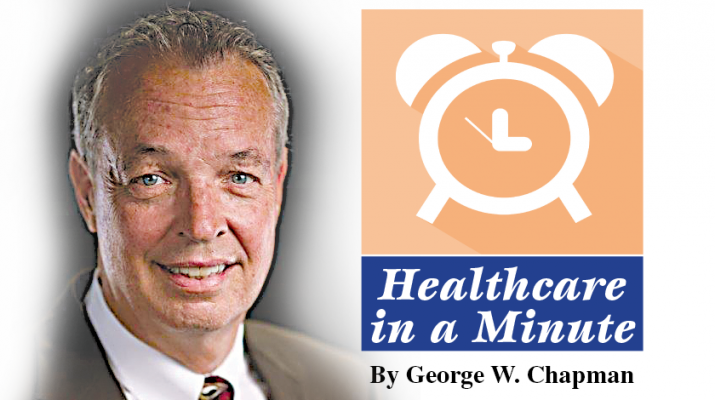By George W. Chapman
The recent requirement for hospitals to post their prices for 300 “shoppable” services, discussed here in earlier columns, has revealed uninsured consumers are charged far more than insured consumers. (They always have been).
A recent survey of 1,550 hospitals by the Wall Street Journal revealed that uninsured patients were billed 3.6 times the negotiated rate with Medicare Advantage plans.
Using their purchasing power, insurance companies typically negotiate volume based discounted prices with hospitals. In the past, the largest carriers in a market would often insert “favored nation” clauses in their contracts, which meant should the hospital offer a deeper discount to a competitor; the favored carriers would automatically get the same discount. Clearly an individual cannot negotiate a volume-based discount like carriers do, but it doesn’t necessarily mean they have to be charged the highest price.
In the past, hospitals feared that if they offered a deep discount to an uninsured indigent patient, it would trigger the favored nation clause.
That no longer being an issue. Hospitals today are far more willing to discuss and negotiate fees in advance.
Impact of Vaccines: 279,000 Lives Saved
A study by the Commonwealth Fund and the Yale Center for Infectious Disease Modeling and Analysis estimates the vaccine rollout has prevented around 1.25 million hospitalizations and 279,000 deaths. The study looked at what would have happened without the 328 million doses being delivered.
An Aetna Foundation study found healthier communities tend to have far less vaccine hesitancy among residents. Traditionally less healthy states, clustered in the southeast part of the country, also have the lowest vaccination rates and highest hesitancy rates. In June, unvaccinated people accounted for 99% of deaths due to the virus. The CDC wants to get more vaccines to family medicine practices as they are highly trusted by the vaccine hesitant.
Ban on Surprise ED bills
Part of the Affordable Care Act is a “no surprise” provision. It prohibits insurers from retroactively denying emergency department claims for services considered not emergent. These denials virtually stick an ED with unexpected collection issues and the consumer with unexpected out of pocket bills. Insurers claim retroactive denials serve as incentives for their members to receive, what they deem to be primary or urgent care, in less costly settings like a physician office, health center or urgent care facility. Most EDs do triage non-emergent patients to their “fast tracks,” but the bills are still much higher than they would be if care was delivered at a physician’s office or urgent care facility. The rapid expansion of urgent care facilities with their extended hours of operation has drastically reduced unnecessary ED use. However, in many rural areas, the hospital ED is often the ONLY alternative for non-emergent care after 5 o’clock, on weekends and holidays.
Demand to Decrease
Healthcare analytics firm Trillant is predicting demand for healthcare services will flatten out or even decline post pandemic. That coupled with an increase in suppliers of services from industry upstarts like Amazon, Walmart and various drug chains means that an industry that has avoided the inevitability of supply and demand, is in for a rude awakening. Does this mean there will actually be real price competition?
Trillant is basing their predictions on 70 billion claims for 309 million visits. Telehealth is already down 37% from pandemic highs. Annual surgical services growth, hospital bread and butter, is now projected to be in the 1% to 2% range versus historical 3% range. Overall, demand will be down. Population shifts to states with lower taxes like Texas, Florida and Idaho will cause demand to increase there but be offset by demand decreases in states losing population like New York, California and Pennsylvania.
Where Should We Invest?
An article by Judith Graham in Kaiser Health News questioned our healthcare spending versus benefits. The recent approval of the Alzheimer’s drug Aduhelm by the FDA inspired the article. $56 billion was invested in the drug with questionable efficacy. It may help one to two million people diagnosed with Alzheimer’s. Not to cast aspersions on the drug, is that prudent spending, mostly by Medicare, when looking at bang for the buck for seniors? Graham queried several physicians asking where they would invest $56 billion to improve care for our seniors and to get the best bang for the buck. The priorities in no particular order are: 1. Make Medicare more affordable. In 2017, the average senior spent $5,800 out of pocket or a staggering 36% of the average Social Security check. 2. Pay for vision, hearing aids and dental. (It should be noted several Advantage plans do offer some coverage here. 3. Support family care givers. 4. Strengthen long-term care. 5. Help people age in place. 6. ASK seniors what they need. 7. Focus on prevention, no matter how old someone is. 8. Study and invest in social determinants of health.
Push for Home Dialysis Reform
Thirty-seven million Americans suffer from kidney disease; 550,000 of them require dialysis. Having to travel to a kidney dialysis center three times a week is a tremendous emotional, logistical, time, transportation, access and quality of life burden, especially is rural areas. Several industry players including home dialysis machine manufacturers, the National Kidney Foundation and the American Society for Nephrology are lobbying congress to remove antiquated or outmoded federal regulations that make it hard for patients to get home dialysis. The coalition’s goals are to modernize conditions for coverage, empower patients and provide a better quality of life.

